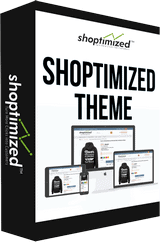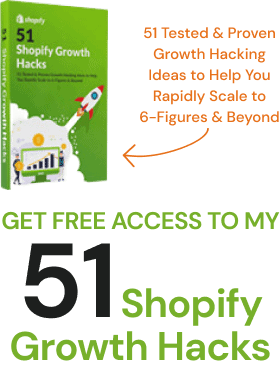If you’re a store owner, you’re always looking to increase Shopify sales.
Are you sending traffic to your product pages without a single sale? Then put things on PAUSE.
The average conversion rate for a store is 2-5%. This means you should make 2-5 sales for every 100 visitors.
If your sales are lower than 2 sales per 100 visitors: SOMETHING’S WRONG.
And you spend more money on traffic won’t help. Stop. Evaluate.
If the traffic you have isn’t working, why would more traffic make a difference? High traffic and low sales is an expensive problem to have.
If I send 100 clicks…I need to be seeing 2+ sales. A really amazing store with exceptional products could see 10.
What is your data telling you? The data doesn’t lie. And if you can make sense of it, it can make you a fortune.
So, back to the big question: “Why is no one buying from my Shopify store?”
This guide is meant to be a walkthrough for each critical problem you might face along the way in turning your Shopify store with no sales into a 24/7 sales machine.
My issue is…
- My ads aren’t getting clicks (Low to no traffic)
- My ads are getting clicks but no add-to-carts (High traffic, low sales)
- I’m getting add-to-carts but no sales (Low conversions)
- I’m making sales but I’m losing money
My ads aren’t getting clicks (Low to no traffic)

No traffic? Wondering how to get more clicks on ads?
Read on to discover why this might be the case.
Your ads don’t tell a story to increase Shopify sales
Don’t try and sell something people don’t know they need. The desire should be obvious.
Are your ads using basic sales text?
- 50% OFF, Act Now!
- Only 100 in stock! Get yours today!
- Love this product? Make it yours today!
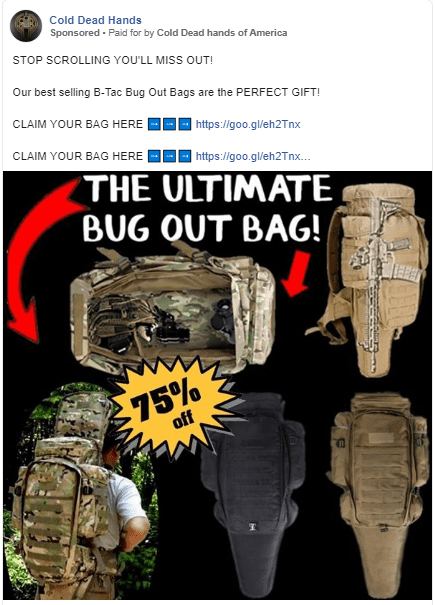
Think of generating sales in your store like growing your own garden. Not all plants have the same needs. Some plants can burn up from too much sun while others thrive in it.
You can’t expect to slap different kinds of plants with different needs into the same garden. Just like you can’t use generalized ad copy to best sell your product.
It begins with your ad’s story.
What do I mean by this?
You can sell a single product in many different ways. Your product can mean different things to different customer types. They each need their own environment to thrive in, just like your garden of plants.
Who is the customer type for a flashlight? Well, anyone who can’t see in the dark!
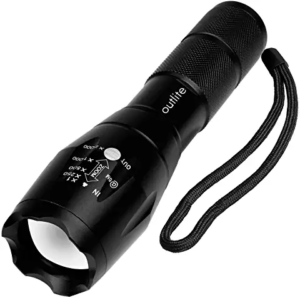
Everyone knows what a flashlight is and does.
But what about more specialized roles?
- Cavers or miners who work/explore underground
- Cable installers, IT admins, and helpdesk who work on network equipment in attics, closets, enclosed spaces
- Mechanics who work under cars in dimly lit garages
- Police, EMT, firefighters who need to respond to calls at night
Same product. Different pain points. Yes, they all need to see in the dark.
But the story you visualize about life before and after the product is very different.
Use those individual pain points to tap into a real market desire and enter the conversation the multiple types of your potential customers are having in their head.
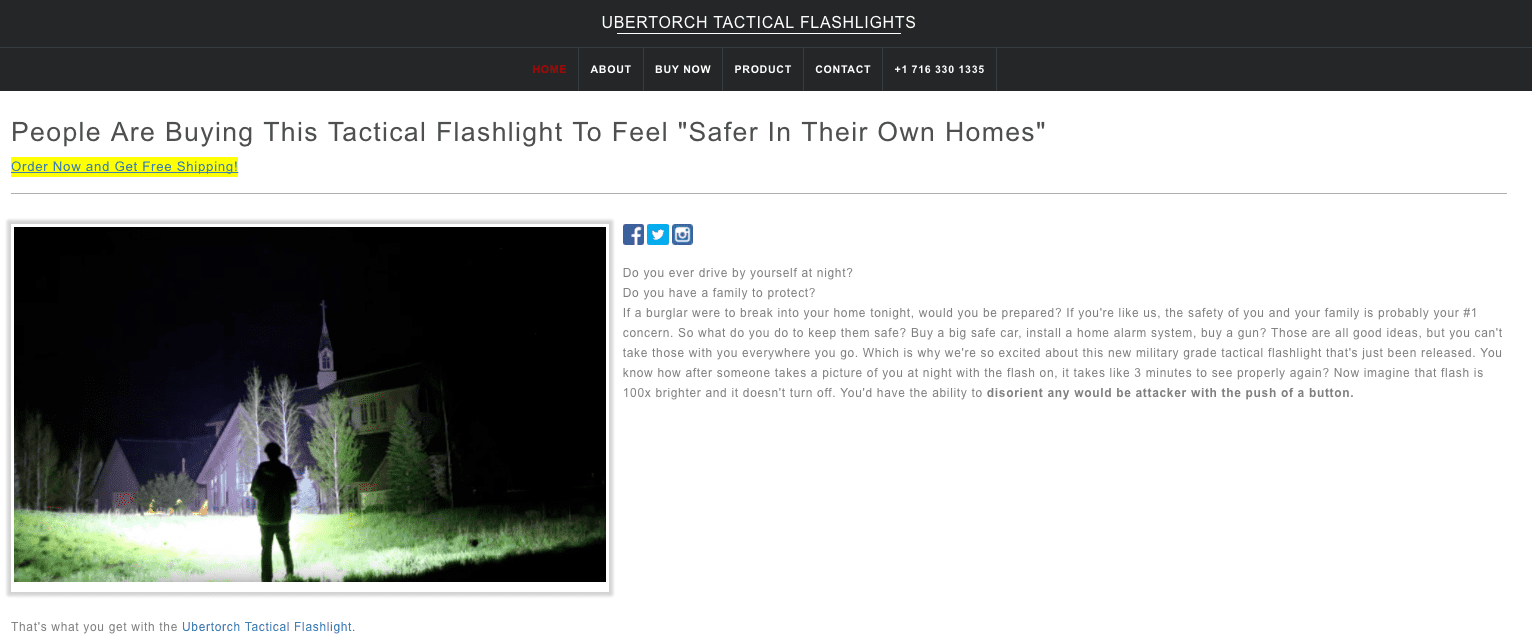
Only then will your ads tell a story and will resonate with your audience.
Pro tip
If you go to niche sites (UberTorch) and see how other products are marketed to that audience, you can an idea of common pain points and desires.
Another example, take something as simple as a microfiber towel.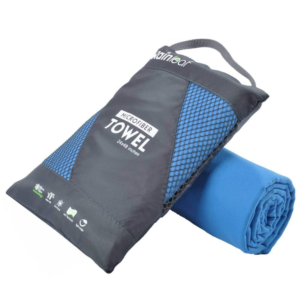
It obviously has one use, to dry things.
But it may be more important to a traveler that it:
- Only weighs 2 ounces
- Comes with a handy convenient packable case.
- Can be washed and dried quickly such as in a hotel sink.
Whereas a gym rat would be more concerned that it:
- Can be used repeatedly before washing
- Is soft enough for your face where sweat can be a menace
- Is mildew resistant in even the most unholy of gym bags
Doesn’t this all seem like entirely better marketing than spamming your discount percentage or inventory quantities?
You can start to see how multiple spins can be used for your ads for the same product. Different customer avatars, same product.
Your product isn’t resonating with the audience
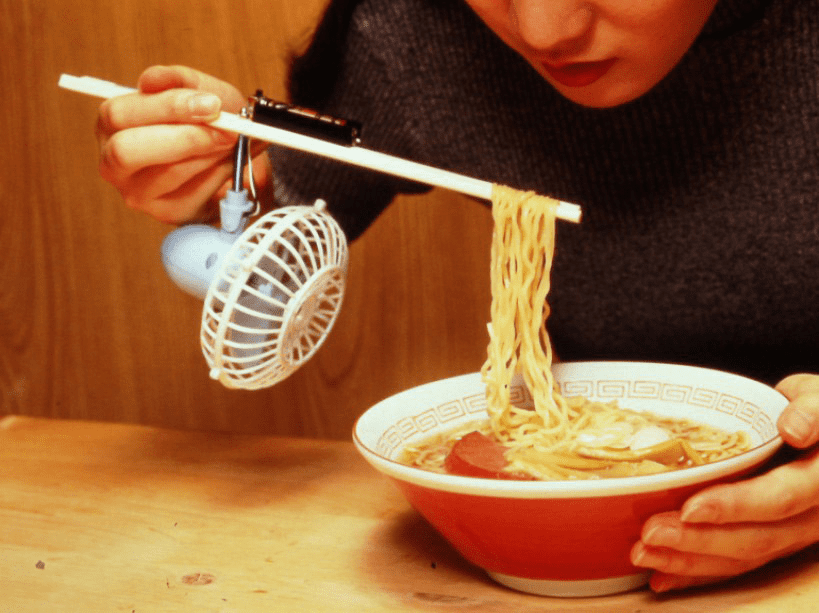
You could be as creative as Da Vinci yet still have a hell of a time selling something if your product isn’t resonating with your audience.
Are you having to convince people they need your item? This is more of a problem with new products where there is not an established level of awareness.
Eugene Schwartz’s Breakthrough Advertising is a legendary book on direct response copywriting and should be on your nightstand if you want to know how to become a top-notch marketer.
One passage comments on the downfall of most ads, “Instead of taking the time necessary to fully understand and articulate our market’s actual “hopes, dreams, fears, and desires,” we make guesses about what they want.”
In Breakthrough Advertising, Eugene Schwartz established the importance of “customer awareness.” Better yet, he systematized it. He identified five distinct levels.
Customer Awareness Five Distinct levels:
- Most Aware. These are the best possible customers. They have the potential to be brand loyal. They’re enthusiastic about your kind of products.
- Product Aware. These prospects know what your product does but haven’t bought it. They’re familiar with your competitors’ offerings. They’re just not sure if your solution is best for them.
- Solution Aware. Solution aware prospects know about solutions like yours, but don’t know your specific product.
- Problem Aware. Problem-aware prospects know they have a problem and have some idea of what that problem is, but they may not completely understand it. They haven’t dealt with this problem before. They’re totally unfamiliar with possible solutions.
- Unaware. These are prospects who don’t realize they have a problem. They simply don’t know a better way exists. If you have a new product that addresses a major drawback of previous solutions, most of your prospects may be at this level.
Hopefully, you are able to see how if you are selling a new product that there’s a level of awareness that must be instilled before a customer is ready to buy.
If your customer doesn’t have a problem, they don’t need a solution. People don’t like being sold crap. It’s not just a target audience, you’re selling to someone’s grandma, brother, son, or mother.
People care about what products will do for them, how they’ll make their lives better, happier, or more fulfilled.
Here are the top-selling levels of “needs” according to Cashvertising by Drew Eric Whitman
The Lifeforce 8 are eight biological desires we’re programmed to respond to:
- Survival, enjoyment of life, life extension
- Enjoyment of food and beverages
- Freedom from fear, pain, and danger
- Sexual companionship
- Comfortable living conditions
- To be superior, winning, keeping up with the Joneses
- Care and protection of loved ones
- Social approval
Which one of these does your product match? Does it match more than one?
Think about the top products you buy and the services you use. How do these match and in what way are they advertised?
Your targeting is off
Can you truly visualize who your customer is?
What do they do when they want to find a product? What websites do they get their news from? Who do they trust? What are their goals and values?
The more you start digging, the more of an idea you get of who this person, or customer avatar, really is and what they like.
For example, let’s say you sell fishing apparel. You’re serving ads to people who show an interest in Fishing but it’s not really selling.
Perhaps you aren’t taking into account the fact that someone probably would have to be REALLY into fishing to buy fishing-related gear, then your targeting may be off.
From there, you would additionally target perhaps a fishing magazine or a franchised fishing store. Have you tried overlapping audiences to find superfans? If someone likes a fishing brand, a public figure in the fishing niche, and a particular fishing magazine, it stands to reason that they’re really into fishing, right?
Use Social Media
Find what your customers are interested in on Facebook and what they like, then you can speak to the conversation they’re already having in their mind.
If a visitor is met with a Google Shopping ad, it makes sense that it’s a product they’re shopping around for.
If you’re using something like Facebook or YouTube ads, your campaigns might not be aligned with your audience.
For example, let’s say that you’re selling a fish oil supplement to people that are into health, but because health is very broad, you have included vegans and environmentally conscious people (who are obviously into health) in your targeting.
You’re selling health but to people that know that the fishing industry is destroying the oceans. Why would they go for your product?
Another question to ask, where is your audience at in the buying process?
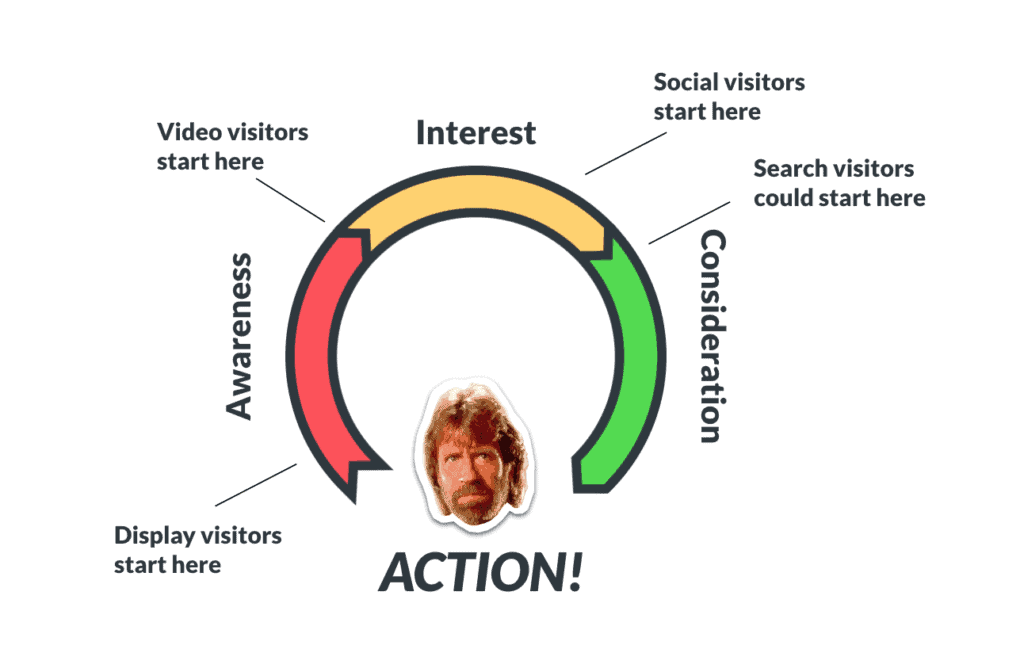
You also want to make sure you’re not targeting people who have already been exposed to your ad. Most ad platforms have some form of ‘relevancy score’. This means if your ad doesn’t get clicks because people have been overexposed to it, you are less likely to get your ad shown in the future.
Use custom audiences and exclusions to remove people who have already taken a certain action to move them further down your marketing funnel and on to a new ad message.
You’re marketing a saturated product
When you sell a product that’s already a top hit with the market, you probably aren’t getting to tell the story for the first time.
People start getting tired of seeing the product. Ad fatigue: If you see the same ad over and over, you stop reading it. Same with products, you desensitize yourself to it.
Even the same product photos can cause people to put a mental ‘block’ on your product.
But saturation isn’t all bad.
It means there’s a demand in the market.
Sales are being made by the marketers that tell a story or were the first to their market. It’s probably just higher at the top of the food chain than what your reach is capable of.
The person who gets the most meaningful transactions with their Facebook pixel installed on their site (also known as seasoning) for a given product or niche first, wins.
Think about it. Imagine 10,000 buyers go through your store. You’d have a pretty dialed-in target for who your audience is with your Facebook pixel.
When you have your Facebook pixel seasoned with tons of transactions in your store related to your niche, it doesn’t matter what product you run ads for as long as it’s relevant to your buyer.
You’ll be able to outmaneuver anyone else while they spend a king’s ransom on ads shooting in the dark trying to play catch up.
Saturation also results from too many ‘gurus’ teaching copycat techniques.
You need to think like an expert-level surfer.
The best surfers pick a wave that’s just starting to swell that’s several waves back. Where they can ride the wave for the longest amount of time.

My ads are getting clicks but no add-to-carts (High traffic, low sales)

Your site is seeing traffic since your ads are getting clicks. However, maybe the bounce rate is high? People browse and then leave? Consider some of these options…
Your site loads too slow
You can do all the conversion optimizations in the world to your website. You can send as much traffic as you want.
But on a slow site? It’s like trying to hold water with a bucket full of holes.
It’s no secret that slow-loading pages mean you’re missing out on hundreds of sales.
However, take heed listening to Google’s PageSpeed Insights. It doesn’t accurately rate the user’s experience.
In July 2018, Google has even stated in regards to speed and SEO that “The “Speed Update,” as we’re calling it, will only affect pages that deliver the slowest experience to users and will only affect a small percentage of queries.”
To get a better idea of your site’s speed, try it yourself. Use a tool like Pingdom that takes multiple factors into account. Run your competitor sites and realize your scores are probably similar.
In fact, research carried out by KISSmetrics, reports that for every one-second delay in page load speed, your conversions will drop 7%.
So what can you do? Doesn’t Shopify have everything ‘under the hood’ on lockdown?
Yes and no. There are still quite a few things you can do to speed up your site tremendously. One quick fix is switching to the fastest Shopify theme by Shoptimized™. You can also read these two articles for hand-holding advice on what to do…
Other relevant conversion rate optimization resources:
-
3 Seconds and You’re Dead: 5 Secrets to Shopify Speed Optimization
-
The Triple Threat That’s Killing Your Shopify Sales & Profits
Your pricing is too high
Are your prices comparable to your competitors?
People don’t mind paying you a higher price if there is another value to be had. If you have a better warranty, faster shipping, etc. then your buyer may buy from you at a higher price. Especially if they’re buying a higher-ticket item.
The first way to check your pricing is to do some competitor analysis on sites like Amazon.com, ebay.com, or a simple Google search and look at the shopping results.

Don’t feel like you have to have the lowest prices and keep undercutting your competitors.
Let me repeat myself, you don’t have to be the lowest price to be the most profitable. Undercutting is a game where everyone loses.
Beyond a certain point, what you price your product at isn’t nearly as important as how you price your product.
Other relevant conversion rate optimization resources:
Descriptions lack salesmanship/storytelling
One of the biggest conversion-killing mistakes I see store owners make is lazily copying and pasting their product descriptions straight from their suppliers with little or no thought for how to persuade visitors to buy.
Product import apps like Dropified are great but they won’t rewrite incomprehensible product descriptions for you.

If the thought of writing unique and compelling descriptions for each of your products fills you with dread, remember you don’t even have to do all your products at once. You can start by working on your best sellers. Never run an ad to a product without making sure the description sells the benefits of your product, not just the features.
Plus, if you want to drive free traffic, Google devalues content that is not unique and is not human-friendly (readable).
If you want to learn how to write amazing, shareable, purchase-enticing product descriptions… then check out our resources that will help you master breathing life into your products.
Other relevant conversion rate optimization resources:
-
How to Write Product Descriptions That Sell: The Ultimate Guide
-
How to Craft The Best Shopify Product Page On The Web
Your images don’t demonstrate the product
I can’t tell you how many times I see a photo of a product that has a close-up of something a buyer has no interest in.
Yes, people want to see quality and value in the images of the product. But you need to speak to the story they are telling themselves as to why they are buying the product.
- What is the product going to do for their life?
- What are your customers asking you about this product?
- How is the product going to make their life better?
- What possible concerns would you have as a buyer shopping for your product?
- How are they going to be using it?
- How can you show what benefit the product can bring the customer?


Let’s talk about how you can use images and/or video to show how to:
- Wear/use the product
- Install the product
- Adjust the product to their customization
- Store the product for convenience
Take a look at HelloTushy
HelloTushy sells bidets. They do an excellent job of demonstrating their product. If you aren’t sure how to use one or even install one, they have simple and straightforward videos that make it easy to understand.
They also use a line-drawn explainer diagram that makes it easy to locate and understand each feature of the product. Much like you would see in an instructional manual.

Humans are visual by nature. Research by Nielson Norman shows that a minuscule 16 percent of readers actually read word-for-word—79 percent just skim for the highlights.
And when shopping online amongst a variety of e-commerce retailers, you can be sure that 16 percent is even lower.
That’s why using images is so important when it comes to conveying important information on where your potential customer’s buying decision is made: your product pages.
Other relevant conversion rate optimization resources:
You’re not answering FAQ’s/overcoming sales-objections
Having frequently asked questions on your store has a ton of benefits;
- It helps minimize confusion surrounding any buying decisions
- It can offset the burden of questions asked to your or your customer service team
- Also, it can help you get your content ranked by search engines
- It helps you get your blog posts seen by customers if you need to provide a more in-depth answer
- It helps you upsell post-sale services or products that you offer in addition to a product
What are some things you should be answering?
- Delivery.
- How to place an order?
- How to track my order?
- What is the estimated delivery time?
- How will my order be delivered?
- What if I am not available to collect the delivery?
- How do I know if my shopping order is confirmed?
- Payment
- What payment methods do you accept?
- Is it safe to pay by credit card/debit card/bank transfer?
- How secure is your payment gateway?
- What financial information do you store?
- How does your store prevent fraud?
- How long does it take to get a refund in case of cancellation/return of orders?
- Cancels and Returns
- What to do if I am not satisfied with the order?
- How do returns work?
- How to cancel my order?
- Which products are not eligible for orders?
- How long does it take to cancel an order?
- How to know the status of my returned products?
- Post Sale Services
- Do you offer installation services?
- How soon can I get my product installed?
- I have got my order delivered. How to install it?
- How can I claim a warranty on my product?
- I lost my warranty card. What to do?
- Whom to contact- brand or you- to fix my product?
A few more tips for your FAQs:
- Don’t feel like you have to just tell your customers your answers, show them! Use images and video to overcome sales objections in detail.
- Answer negative questions in a smart way. Be honest and show transparency of how you can or can’t achieve the desired outcome
- Be simple and concise. Don’t further confuse your customers with jargon or a sales pitch. Keep the answers basic and link to other resources as needed.
Your delivery times are more than a week
Research carried out by Milo revealed that 1 in 4 online shoppers abandon their purchase because the estimated delivery date wasn’t available.
And to make things worse, 38% also abandoned because the expected delivery date was longer than a week.
That’s bad news if you’re dropshipping and have longer delivery times… quoting 4-weeks delivery is going to be a complete conversion killer for your store. If you do have long delivery times, explain why.
Overcome the objection by explaining: because of high demand, weather, hard-to-find materials, etc.
The Baymard Institute’s Checkout Usability Study shows that what users really care about is not “shipping speed” but rather the date of delivery, as in: “When will I receive my order?”

This is particularly important if your store sells products that are often bought as gifts, many late shoppers will want peace of mind that their order will arrive in good time.
And because we have seen the conversion-boosting effect of offering delivery prediction first-hand, we built this feature into the Shoptimized™ Theme (the best converting Shopify theme). You can even do this on a per-product basis if you have multiple suppliers with different shipping times.
Other relevant conversion rate optimization resources:
Your returns and refunds policy sucks
If you dropship, you probably have little control over the actual return policy of your products.
However, a whopping 67% of online shoppers check the returns page before making a purchase.
It begs the question if that many people are looking at your e-commerce returns policy page: Why not design the returns process in your favor to win over those people with a cart full of items trying to decide if it is worth buying from you?
Any attempt to deter them through complicating the information makes it feel like an attempt to blindside them and lock them down into a product they are dissatisfied with.
Don’t make them dig around in the footer for your return information. Have it readily available on any given product page.

To increase Shopify sales from winning trust with return policies, check out more resources below…
Other relevant conversion rate optimization resources:
-
5 Ways Your E-Commerce Return Policy is Sinking Your Profits
-
Risk Reversal – An Audacious Way to Melt Away Sales Resistance
-
5 Ways You’re Killing Your Store’s E-commerce Conversion Rate
Your site looks spammy/untrustworthy/no reviews
Does your business website feel like the underbelly of some shady operation?

People do business with businesses they trust.
Easy contact
Consumers are most likely to trust a business that makes it easy to contact people at the company. That means putting your phone number at the top of your website proudly. Live chat. Contact forms. The works.
Make sure you are actually using your store’s domain with your email address. Not just a Gmail address.
Something along the lines of [email protected] and make sure to have a personal email with your domain that you are using such as [email protected].
GSuite is the easiest, most cost-effective way to set up a business email for your store.
Everything to prove that you are there to help guide a customer with any questions makes it that much more trustworthy, even if they don’t necessarily need it.


Reviews
As the barrier to entry in the world of e-commerce gets lower and lower, consumers have to be more skeptical of fly-by-night shops that sell low-quality goods. How do you combat this?
Let’s take a look at some statistics on consumer trust is built.
- 81 percent of consumers trust the advice of friends and family over businesses.
- As cited in SEJ, Econsultancy declares that 88% of customers will check out the reviews before making a final decision on a purchase.
- According to studies, 72% of consumers trust online reviews as much as personal recommendations (Local Consumer Review Survey, 2012).
If you aren’t using reviews, then you’re missing out on a powerful tool of consumer persuasion.
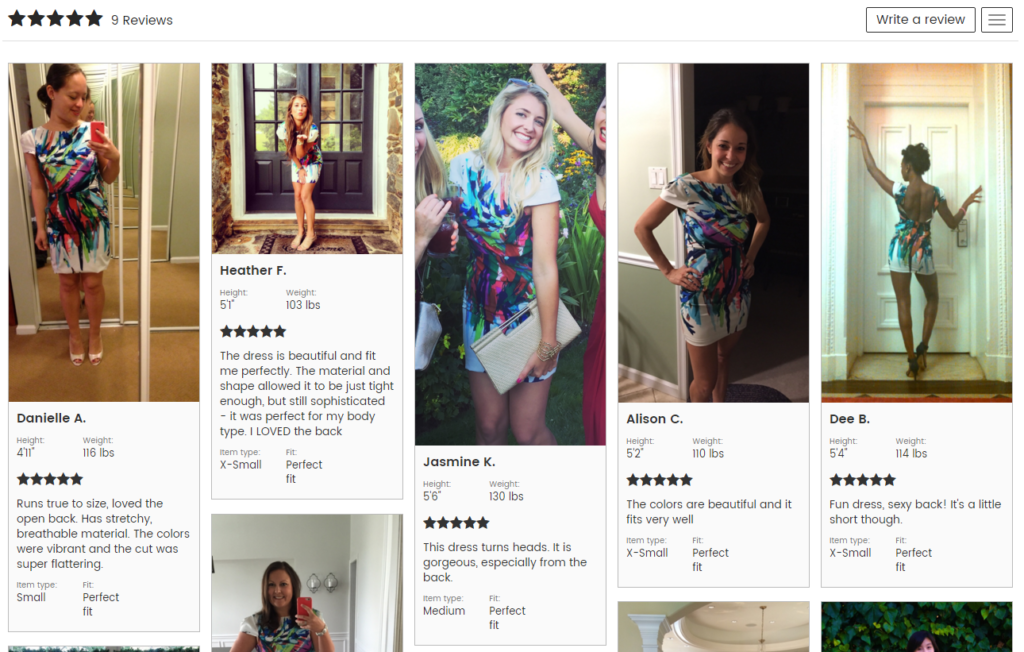
Consumers trust product reviews and photos much more than marketing assets. Fortunately, there’s an easy way to collect reviews from your customers.
Use an app like Loox to easily collect photo reviews, build strong trust and increase sales
Turn your happy customers into your brand ambassadors, build strong trust and increase Shopify sales with photo reviews.
The Shoptimized™ Theme also has a social proof built right in.
- Volume Purchase Social-Proof tells your shoppers how many other customers bought more than 1 of an item and helps encourage people to buy in bulk.

Pop-Ups

Sumo analyzed nearly 2 billion pop-ups and found that despite people thinking pop-ups are annoying, they are absolutely effective.
However, context is crucial or pop-ups can work against you.
“Of the top 10% of pop-ups, only 8% had pop-ups appear in the 0-4 second mark. And the majority of that 8 % were on pages where the pop-up was expected to appear quickly – as in sending someone to a download page. On the flip side, guess what the lowest-converting pages had in common? Rushed pop-ups.“
The frequency at which a pop-up occurs is just as important. Make sure that your pop-up doesn’t keep coming back on each page your visitors’ visit.
“A good rule-of-thumb default that the best pop-ups follow is a one-day minimum. If you’re a highly trafficked site, though, you can scale it back to 2+ days to ensure you don’t annoy visitors.”
Logo and Branding
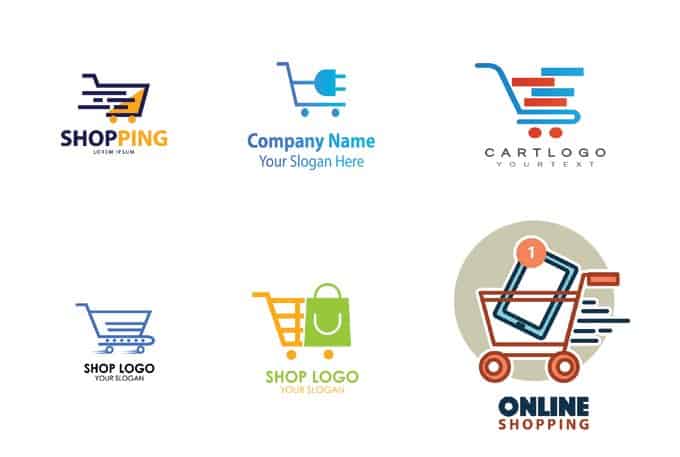
Your store’s logo is the first impression. It is the first contact point of showing your brand and what your consumers can expect from you.
How memorable is your logo? A brand can change the perception of a product or store.
People will rationalize on some level that if you put time and effort into your look then you will put time and effort into them as a customer.
Other relevant conversion rate optimization resources:
-
How to Create a Tagline That Sells
-
Fiverr Gig
-
How to Craft Your Store’s Value Proposition
-
7 Elements Every Email Entry Pop-Up Needs to Rake in New Subscribers
You’re not giving people a reason to buy now rather than later
According to a study by Qubit: Scarcity, urgency, and social proof were the top 3 influences on conversion.
So if the top 2 reasons why people are more apt to buy something is giving them a reason to buy it now, why not implement it into your store?
- Do you have limited stock?
- Do you have a sale that is ending?
- Is there an upcoming gift-giving holiday that your customer would be browsing for?
As legendary copywriter Gary Bencivenga says “In most people, the fear of loss is a much stronger motivator than the desire for gain”.
So by making users feel that the deal they want is going to go away, you can create a sense of scarcity and urgency. Shoptimized™ took this to heart and created some core features of the theme to include these principles of urgency and scarcity.
- The Exit Pop-Up grabs cart abandoners’ attention. You can offer a percentage discount or money off. A last-minute discount offer is a proven way to increase Shopify sales.
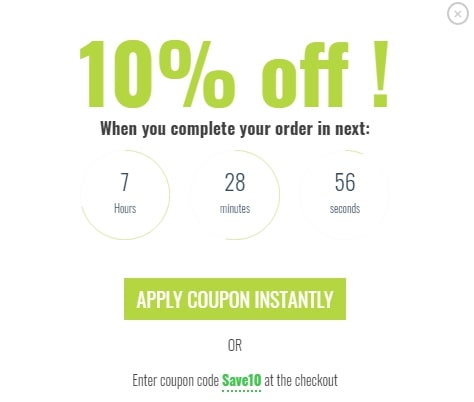
- Is your product only available for a limited time or you have a special offer that ends soon? Scarcity With Remaining Stock is a fantastic feature to leverage scarcity and urgency to get people to act now.
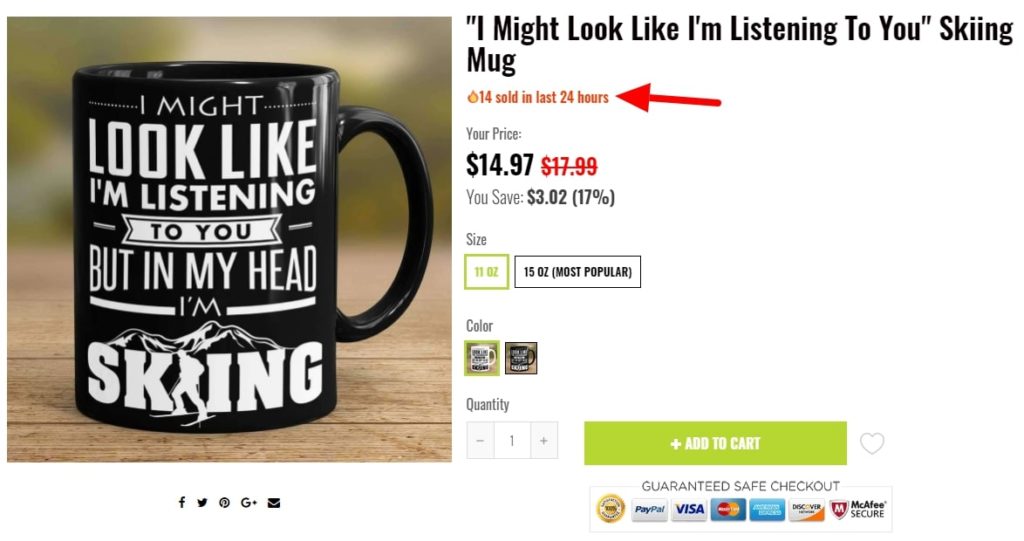
- Shoptimized™ added an optional Urgency With Countdown Timer on the cart page to help motivate users to complete their checkout. With this feature, you simply add a tag to whichever products you want to display a countdown timer for.
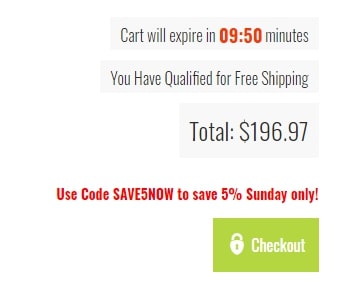
Other relevant conversion rate optimization resources:
You have no value proposition
The reality is that every single one of your store’s shoppers will ask – usually sub-consciously – but which ridiculously few e-commerce store owners bother to deal with.
“Why should I choose you?”
Before they get their wallets out, they want to feel that they’re in the very best place to get whatever it is you’re selling and don’t need to bother looking elsewhere. Especially with Amazon becoming more of a global e-commerce giant.
For example, younger consumers care about product and workforce sourcing/ethics.
- Everlane.com shows its factories and ethics.
- Dr. Bronner’s, the organic soap company, has their founder’s eccentric social and environmental justice printed directly on the label of each product.
- Lush prides itself on several ethical values that run their business decisions.
Sometimes by bundling a few together, you end up with a sort of packaged USP or a “Value proposition” as I like to call it.
List of 24 things to get you to start thinking about what sets your business apart:
- Are you unique?
- Cheaper?
- Quicker?
- Better value?
- Safer?
- The most trusted?
- Friendliest?
- The first?
- A top seller?
- The most tested?
- Give a quicker service?
- The most advanced?
- The latest?
- Oldest?
- The most loved?
- The most ethical?
- Do the one experts prefer?
- The most reliable?
- More fun?
- Sold in a special way?
- Easier to deal with?
- More helpful?
- Sourced in a special way?
- Caused based?
I know it can seem hard to find a point of difference if you’re selling something that isn’t unique, especially as the business owner, you’re on the inside of the bottle trying to read the label, so to speak.
But dig deep and put the time into nailing your value proposition, it will reward you now and long into the future.

The age of the internet has leveled the playing field for a lot of businesses and now more than ever it is almost more important to know WHO they are buying from.
In fact, 52% of respondents in a web usability report by Hugg/KoMarketing reported they wanted to see information about the company.

They can get it from anywhere, but why should they get it from you?
Other relevant conversion rate optimization resources:
-
How to Craft Your Store’s Value Proposition
-
How to Build An E-Commerce Brand That Will Stand The Test of Time
Too many variants
You’ve probably heard of the famous jam experiment. If not, it’s worth remembering.
Sheena Lyengar from Columbia University set up a table laden with jams outside of an upscale grocery store in Menlo Park, CA.
Over a period of two consecutive Saturdays, research assistants dressed up as store employees and offered samples of either 6 or 24 flavors of Wilkin and Sons Jams, a British jelly purveyor known for exotic flavors.
Before this study, the common marketing theory was that more choices are better for customers. People like having more options, so offering more flavors should increase Shopify sales. Right?
The results were more than a little shocking.
When 24 flavors were offered, 60% of people stopped to sample the jams, compared to 40% when only 6 flavors were offered.
This seems in favor of more choices, right? Sampling more leads to buying more, right?
Of the customers who sampled 24 flavors, only 3% purchased, but of the customers who sampled 6, 30% purchased..
If you run those numbers based on 1000 people, 600 would stop when 24 flavors were offered, with only 18 purchases (3% of 600).
When 6 flavors were sampled, 400 stopped at the table, and 120 purchased (30% of 400).
Which table would you want your products on?

Take a good hard look at the options you are offering with your products. Are you inadvertently causing paralysis by analysis?
Don’t let your variation offerings cause your store to lose sales.
Another huge downfall of offering too many variations is that your store’s product page load times will suffer greatly.


Other relevant conversion rate optimization resources:
-
How to Identify Your Shopify Store’s Conversion Killers – Article Series
-
5 Ways You’re Killing Your Store’s E-commerce Conversion Rate
I’m getting add-to-carts but no sales (Low conversions)

You’re not offering Paypal
Convenience is king, although it costs you more per sale, it’s worth it for the extra conversions.

Research firm Nielsen notes that, on average, PayPal customers complete their transactions 88.7% of the time. PayPal Checkout conversion is, on average, 60% better than “other digital wallets” and 82% better than “all payment types combined”.
(Source: ComScore online panel, Q4 2017. The analyzed shopping behavior of 1 million US consumers on 20 large merchant sites. Checkout conversion is measured from the point where the consumer selects a payment type to completion of purchase.)
The study also found that 55 percent of customers said they made more online purchases because of PayPal OneTouch.
“PayPal OneTouch™ lets customers shop from site to site without entering their password or filling out their billing information, so they can pay in just a few taps. It turns a multi-screen checkout into an express lane on most devices. Checkout conversion can be up to 47% better for PayPal versus non-PayPal transactions via PayPal.”
On another note, much like product variant options, you don’t want to go overboard with payment options. In my opinion, it can have the same effect where your customer gets “choice overwhelm” about which option to use.
Your theme doesn’t make it clear that an item has been successfully added to the cart
I’ve seen themes where it looks like the developers WANTED your store to go bankrupt.
Some themes are entirely too confusing for the consumer: whether or not they added an item to the cart, how to get to the checkout, etc
Your visitors leave in frustration or end up adding multiples by mistake. This leaves a bad taste in your potential customer’s mouth and they walk away probably to never come back.
You’re probably used to seeing this chart, but if not, it’s worth keeping around:
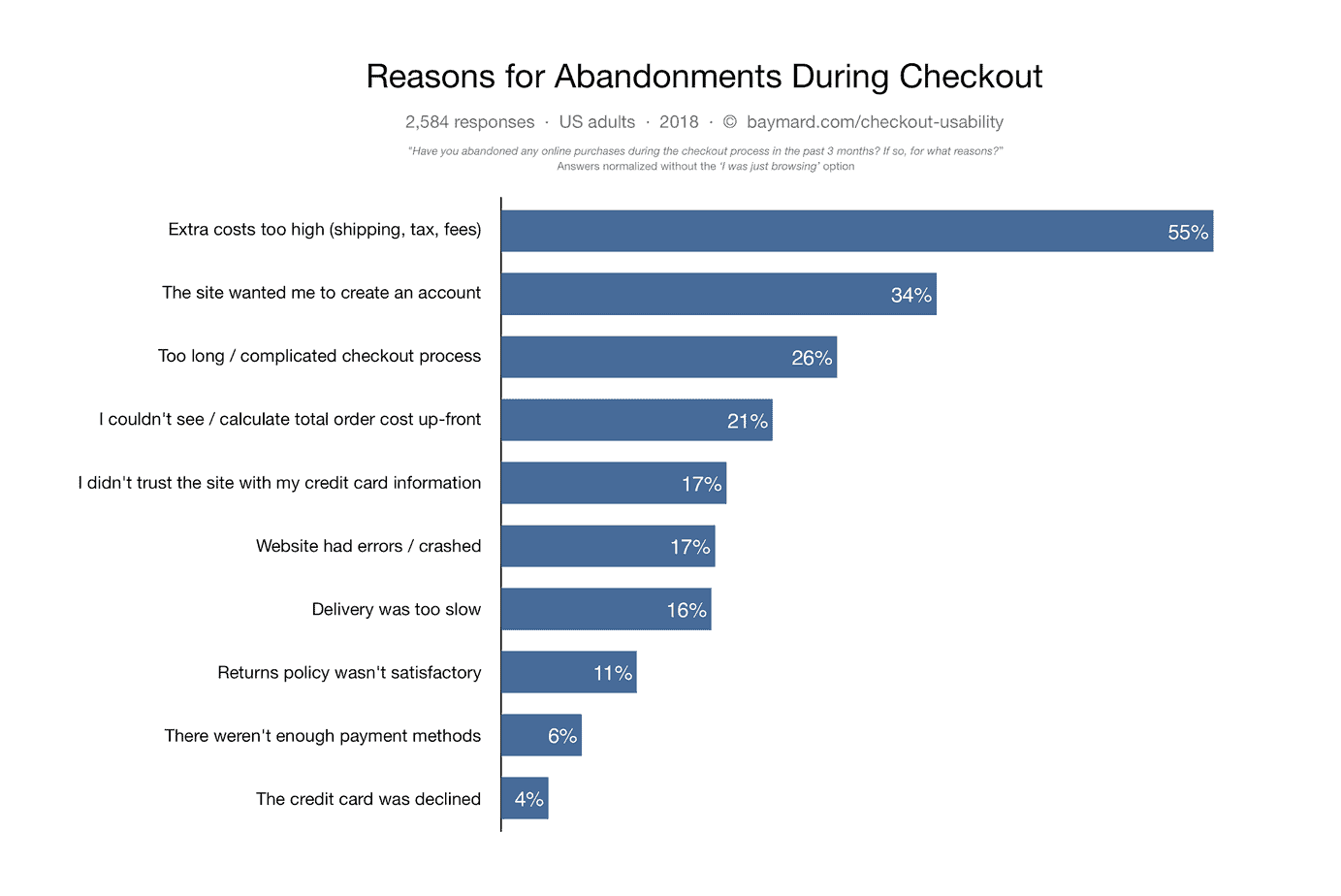
Over 26% of respondents in a Baymard Institute survey said they abandoned shopping carts due to the checkout process being too complicated. 21% said because they couldn’t see their total order cost up-front. 17% said because the website had errors/crashed.
These are all factors that can be attributed to bad theme design. Remember, you can’t cash checks with style points.
It doesn’t matter how good it looks if it’s sabotaging your store.
So let the trendy aesthetic take a back burner and wipe your tears with your profits after using the best converting Shopify theme by Shoptimized™ to increase Shopify sales.
Other relevant conversion rate optimization resources:
-
30 Must-Have Shopify Dropshipping Theme Features
-
13 Problems With Your Shopify Store and the Best Shopify Apps to Help
You have an upsell pop-up that’s disrupting the user flow
Although pre-purchase cross-sell apps may increase your AOV, your overall conversion rate may suffer. This is because these apps create friction for your visitors because they stand between adding the item they originally wanted and viewing the cart/checkout.
What’s worse is if these pop-ups aren’t set up correctly and your visitors are being offered totally irrelevant products. This causes irritation and your sales will suffer.

Not only that, but these apps can significantly increase your page-load speed resulting in a higher bounce or abandonment rate.
This unintentional side-effect means overall, you may well be worse off than you were without the upsell pop-up.
But it doesn’t have to be this way, UpliftHero routinely cross-sells products to your customers without interrupting their user experience or the checkout flow.
And to make sure your cross-sells get maximum exposure, UpliftHero cleverly places them immediately under your Add-to-Cart button—just where your visitors’ attention is focused when they’re ready to buy.
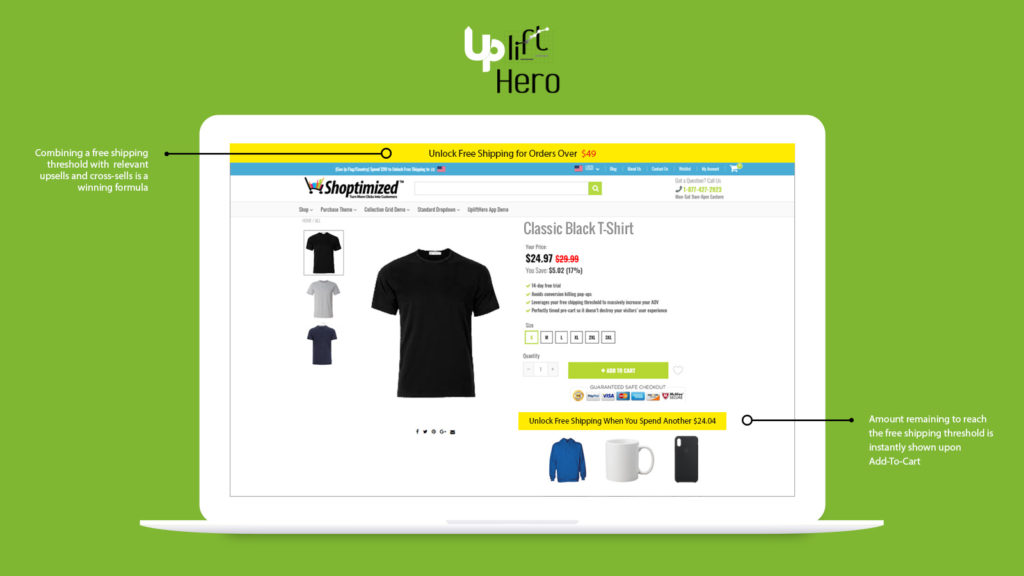
Designed to Leverage One of The Most Powerful Principles in e-Commerce
UpliftHero rewards and incentivizes your visitors to add more items to their cart by leveraging your free shipping threshold (one of the most powerful motivators in e-commerce).
It’s no secret that offering a free shipping threshold can massively increase your average order value.
All this means a massive increase in AOV without sacrificing your conversion rate, plus reduced cart abandonment compared to other apps.
Fully customizable:
- Want to only offer cross-sells on certain products? No problem
- Choose the incentive you offer to get people to spend more
- Avoid showing irrelevant cross-sells to your customers
- Customize the look and feel to suit your brand
Check out UpliftHero today.
Other relevant conversion rate optimization resources:
Your shipping costs are too high/not free
Here’s a helpful case study from e-commerce store NuFace, they tested adding a free shipping threshold and it increased its orders by 90%.
They simply placed a “free shipping over $75” slogan above the “Shop NuFace button” – an intelligent move, which took into account where the target customer would be looking on the page and placed the incentive near it.

The research also showed approximately 60% of e-commerce store owners cite free shipping with a threshold as their most successful marketing tool. This makes total sense because a lack of free shipping is the top reason consumers abandon their online shopping carts.

So, if your AOV is $40, offer free shipping for orders over $49.
And to prove this works, one of the many findings in a joint study by Harris Interactive & UPS was that 39% of customers reported they’ll often purchase enough to qualify for free shipping when there’s a threshold to meet.
When you set a threshold, it typically increases your average order value because shoppers will buy more items to reach your threshold.
Or in other words, sell more stuff to each customer you get.
How can you do this in your store? Like we mentioned: UpliftHero is a sales machine when it comes to harnessing the power of free.
UpliftHero rewards and incentivizes your visitors to add more items to their cart by leveraging your free shipping threshold (one of the most powerful motivators in e-commerce). It also includes a Thank You Page upsell app.
Other relevant conversion rate optimization resources:
-
The Scary Effective Power of Shopify Free Shipping
-
Free Shipping vs Threshold – At What Point Should Delivery Cost?
Your checkout design is inconsistent with the rest of your site

Your Shopify design is how you show your trustworthiness. It’s like a storefront.
Things to keep in mind:
- Is your phone number clearly visible?
- Do you state that you have SSL certification (secure ordering)?

- Do you state you have safe methods of payment? PayPal or credit card gateway

- Is your checkout button color standing out in comparison with the rest of your site design?

Other relevant conversion rate optimization resources:
Your retargeting strategy is lacking to increase Shopify sales
92% of consumers will visit a brand’s site for the first time for reasons other than making a purchase, according to a study by Episerver.
What happens to those visitors who come to your store and then forget about you? How are you supposed to get them back?
The “Reimagining Commerce” report found that of shoppers visiting a website for the first time, 45% are searching for a product or service, 25% are comparing prices or other variables, and more than one in 10 are looking for store details.
What does this mean for your store? If you aren’t implementing retargeting, you’re missing out on a huge opportunity to market to customers who are already warmed up to your brand.
91% of marketers who have used retargeting have found it to perform the same as or better than search, email, or other display ads. [Source: Adroll]
Retargeting works. Let’s take a look at how well it works the more a potential customer is exposed to a given retargeting ad.

What all should your retargeting campaign include?
-
-
- Cart abandonment emails
- We recommend Klaivyo for the Shopify app
- Check out our article on e-commerce emails that sell
- 16 Tips to Claw Back Abandoned Carts
- A persistent cart
- Push notifications
- We have a new app (SmartSuite) that includes push notifications AND a persistent cart feature
- SMS – SMS Bump App
- Chatbots
- Adroll (Expensive but includes multiple platforms)
- Google (Google Display Network, YouTube, Mobile Apps)
- Cart abandonment emails
-
It also needs to be in stages:
-
-
- “Hey! You forgot something” or Your cart is waiting for you!” (Awareness of purchase)
- Showcase customer reviews (Social proof, combat sales objections)
- Reasons to come back and buy (Value proposition)
- Alternative products from the same collection
- Facebook Product feed required – This covers people that didn’t quite find what they wanted but still are familiar with your brand
- Introduce a discount (Exclusivity)
- 24 hours remaining on the discount (Create urgency and scarcity)
-
Other relevant conversion rate optimization resources:
-
E-commerce Emails That Sell
-
16 Tips to Claw Back Abandoned Carts
-
The Two Most Dangerous Competitors Facing Your E-Commerce Store
-
Facebook Ascension Formula – Retargeting Masterclass
I’m making sales but I’m losing money

Adjusting your ad creative
This is similar to the first point we talked about. If your ad isn’t converting, spending more money isn’t going to fix it.
Pause your campaign and reflect on if your ads are resonating with your audience.
Always ask yourself the different types of customers you are selling to. Multiple spins can be used for your ads for the same product. Different customer avatars, same product.
Adjusting the ad traffic source
Are you selling to the wrong crowd?
There are many different metrics in which you can filter visitors to your site and make adjustments to your ad spend.
Perhaps mobile converts too low compared to desktop? Bid more aggressively on desktop and cut down on mobile spending.
Maybe YouTube video ads are costing you more and not converting as well? Switch to spending more on Facebook ads with product showcasing where your ads are converting better.
Spotting trends in your conversion data and what percentage of traffic actually turns into a sale is crucial for making the most of your ad spend.
Adjusting your geographic targeting
Imagine you’re a Shopify store owner that sells surf gear. You are targeting the USA as a whole with your shopping ads.
But you start to notice, your main customers are on the west coast. And your landlocked audience visitors are just browsing and costing you valuable ad spend that you could be used to target ads near the coastal regions.
Analyze carefully if you are targeting too specific. Use a general high-level traffic source as a baseline and then find out what and where your high converters are.
This is another tool in your arsenal to increase your return on ad spend.
Your cost per purchase is too high
Knowing your Customer Acquisition Cost (CAC) gives you a better understanding of how effective (or ineffective) your marketing is.
CAC tells you how much you are actually spending to get each new customer and is the foundation to more calculations that are vital to your Shopify store profiting.

Take your advertising spend in a given period of time and then divide that by how many customers you had.
If you spend $1000 advertising your products and made 100 customers, then your CAC of that advertising campaign was $10 per customer.
Is $10 a good customer acquisition cost?
Well, that’s like asking: Is $5,000 a good price for selling a car?
It all depends.
It comes down to your ROAS (Return on Ad Spend). Which essentially means, how much revenue are you making when you spend money on ads?
Are you selling clunkers or Ferraris?
When you know…
-
-
- How much your average profit per sale is
- How many times a customer will buy from you over the lifetime of a customer
-

Other relevant conversion rate optimization resources:
Your Average Order Value is too low to increase Shopify sales
If your average order value (AOV) isn’t where you need it to easily get a return on your ad spend, fear not…
There’s a multitude of strategies that can raise the bar for your profit margin:
Bundle your products.
Do you sell a product that requires other products for the best experience? What about a product that is a recurring purchase?
When you show that you can save your customers money, they’re more likely to order more from you.
Upsell products.
This works well with bundling. Can you upsell more of the same product for cheaper? What about a newer version of the product that might benefit the customer more?
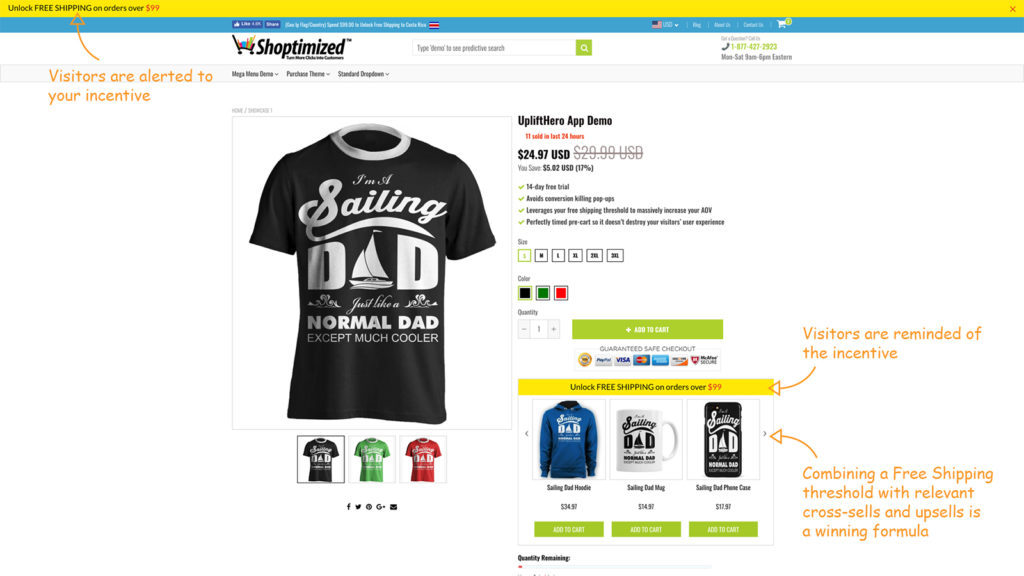
This doesn’t mean trying to scam your customers into buying something they don’t need, it’s selling them for better value. Use UpliftHero to start upselling today and raise your store’s AOV through the roof.
You can also implement FunnelBuildr to implement one-click upsells after the purchase for an even bigger AOV boost.
Free shipping threshold.
Amazon has trained the world to expect free shipping. A study by UPS found that 48 percent of consumers said that they added items to their shopping carts to qualify for free shipping.
If you’re selling products that are relatively low cost and can be bought pretty much anywhere, this is where you should impose a threshold.
This is because price sensitivity plays a big part and upping your prices to absorb the shipping costs will mean you might price yourself out of the market.
Start a loyalty program.
What keeps customers coming back for more? Rewarding them with special offers. A lot of companies offer discounts for new customers, but what about the person who has already bought from you?
Don’t just send out generic coupon codes to your email list. Codes like this can be hunted down on sites like Retail Me Not.
Instead, make it targeted to where the customer can track their reward points.
Target customers by purchase history.
When you know what a customer has purchased from you, you can show more personalized offers and increase Shopify sales. This is a great way to increase your customer experience as well as increase your average order value.
A good place to start is by segmenting your email list into different segments so you know the level of product awareness your buyer already has.
Use live chat to help the sale.
A study by the American Marketing Association study shows that live chat can increase conversions by at least 20 percent. Not only that, but the same report states that visitors who use live chat are three times more likely to buy, compared to those who don’t.
What’s more, 33% of consumers now expect to see live chat offered on every website so if you’re not, you’re disappointing a third of your potential customers.
Other relevant conversion rate optimization resources:
Your customer experience sucks
What are you doing to put a personal touch on your business? Reviews and repeat purchases are the lifeblood of this business.
Any of the suggestions you’ve read in this article will, in some way, contribute to your overall customer experience. But let me reiterate the more important suggestions and also suggestions that may not have been mentioned.
Product Search.
If people know what they want, make it easy for them to search. Go a step further and make product filtering easy to use.
Let customers browse products but also filter down based on features so they can get a better idea. Show products your customer has recently viewed.
Easy Checkout.
Offer multiple payment options. Don’t ask for the same information twice. Make sure your theme makes it obvious when there is a product added to your cart. Make sure you’re offering guest checkout.
Mobile Design.
Mobile dominated (Black Friday and Cyber Monday) 2018 on Shopify, accounting for 66% of sales.

Google research shows that 73% of consumers will jump from a poorly designed mobile site to one that makes purchasing easier.
A lot of times, store owners will install tons of apps that clash with each other on mobile design. Such as a live chat button displaying on top of an add to cart button.
So what does all this say? It pays to have a mobile-first theme design.

Customer Support.
Offer live chat. Show your phone number in the header. Follow up via email after purchase. Customize the emails so that they use the customer’s name and the product they purchased.
Improve Your Product Page. Make sure they’re packed full of reviews. Use Loox to easily collect photo reviews, build strong trust and increase Shopify sales. Make sure you have high-quality photos of your product. Multiple angles. Even 360-degree views.
Delivery Times.
Keep your customers updated on where their stuff is! Make sure it gets there quickly. Research carried out by Milo revealed that 1 in 4 online shoppers abandon their purchase because the estimated delivery date wasn’t available.
Poor Quality Suppliers or Packaging.
Make sure to vet your suppliers before doing business with them. Opt for US suppliers. Dropshipping from AliExpress and having Chinese writing all over your packaging is a surefire way to lose your customer’s trust.
Instead, use places like CJ Dropshipping that source product. This removes this element of mistrust and makes a more professional customer experience a lot easier to implement.

Other relevant conversion rate optimization resources:
Your follow-up funnels are non-existent/weak to increase Shopify sales

For implementing the methods of getting your customers back into the beginning of your funnel, as shown above, you can use the following resources:
-
-
- Cart abandonment emails
- We recommend Klaivyo as an email service provider
- Check out our article on e-commerce emails that sell
- Push notifications
- SmartSuite includes push notifications AND a persistent cart feature
- SMS – SMS Bump App
- Chatbots
- Adroll (Expensive but includes multiple platforms)
- Google (Google Display Network, YouTube, Mobile Apps)
- Cart abandonment emails
-
The numbers have been adjusted over the years but it’s a consensus that it is 5-10x more expensive to acquire a new customer than to retain a current one.
Don’t think your customers will shop elsewhere once they buy with you? A study from Oracle found that 89% of customers begin a business with a competitor following a poor customer experience.
Don’t think it could happen to your store? Fifty-two percent of customers have switched businesses in the past year due to poor customer service. (Accenture)
So what’s an advantage to keep your customers around after the initial purchase aside from the reduced cost of acquisition? Well, Oracle also found that 86% of consumers will actually pay more for a better customer experience.
As you can see in the funnel image above, loyalty programs are a part of earning repeat business.
Set up a loyalty program that’s tied to an app. Sixty percent of consumers say they’re more likely to join a loyalty program that’s tech-savvy.
That’s why we recommend using Smile in your Shopify store.
It’s no secret that the real money is made in the 2nd purchase and beyond.
How can you stay in contact and make sure your business is at the forefront of your existing customer’s minds? Email marketing is key. But it doesn’t stop there. Also SMS and Chatbot.
Other relevant conversion rate optimization resources:
Conclusion on How to Increase Shopify Sales
My goal with this guide has proven to be a valuable, bookmark-worthy resource for you to refer back to. This page will be updated regularly with new articles and resources, so make sure to check back. If you have any questions or comments, please leave a comment below.
Last but not least, if you want a way to knock out a lot of the sales-killing problems that plague Shopify store owners, then I have your secret weapon.
Get the highest converting Shopify theme by Shoptimized™ today to eliminate multiple conversion killers once and for all.
Final Word on How to Increase Shopify Sales
Hotjar is a great tool for uncovering other reasons for any of the above. To learn more about what may be keeping you from getting Shopify sales, check out our other conversion optimization articles:

